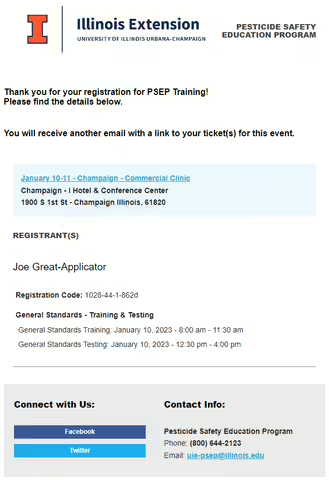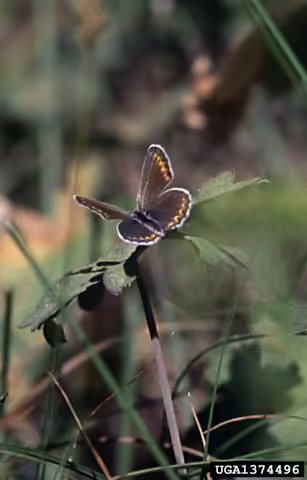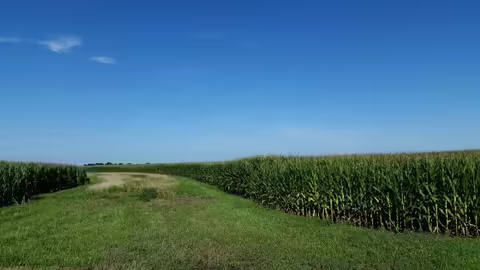
New Registration and Check-in Process for Illinois Pesticide Safety Education Clinics
If you plan to attend a University of Illinois Pesticide Safety Education Program training clinic this year, you will likely notice that we have updated our registration system. Among the many improvements, the new system allows us to use barcode scanners to simplify and greatly speed up our check-in process. In previous years, PSEP staff needed to search through long lists to check-in each attendee manually. This often resulted in long lines. So far, the system has worked well, at least for those who remembered to bring their registration tickets. This is a new system for all of us. Here are some tips to speed up your check-in process when you arrive at the training clinic.
First and foremost, bring your ticket(s) to the clinic and have them ready to scan when you get in line. While this may sound easy, forgetting to print or bring ticket(s) has been our primary issue with this new system. Upon completing your registration, you will receive separate emails with the following subject lines and information:
- “Registration Details” This email includes the dates, times, and locations for your training sessions.
Sample “Registration Details” email. Not your ticket(s). - “Transaction Receipt from U of I Crop Science for $XX.XX (USD)” This is an automatic receipt generated by the payment processor.
- "Your Ticket(s) - Pesticide Safety Education Program“ For some registrants, the subject line may instead read “Your Pesticide Safety Education Program Tickets”. This email contains a link to your tickets. Be sure to open the email, then click the blue “Print your ticket(s)!” link. You can either print your registration ticket or have it ready to view on your phone. Many individuals have printed the registration details email and overlooked the email with the ticket(s). If you are registered for multiple training sessions, be sure to print tickets for each training session that you have signed up for.
Sample “Your Ticket(s) - Pesticide Safety Education Program” email. Click the blue “Print your ticket(s)!” link to access your ticket(s).
No Printer? No Phone? No Problem! We realize that not everyone has a printer or a phone capable of displaying the ticket(s). You can also write down the ticket number located directly below the barcode for each session you registered for. If you lose or forget that piece of paper, we can still check you in using your first and last name. We look forward to seeing you at one of our upcoming training clinics.
Change Coming to How EPA Protects Endangered Species from Pesticides – Feedback Needed
Recently, the U.S. Environmental Protection Agency (EPA) released an Endangered Species Act (ESA) Workplan Update that outlines major steps to increase protections for wildlife and regulatory certainty for pesticide users. The Workplan Update details how EPA will pursue protections for nontarget species, including federally listed endangered and threatened (i.e., listed) species, earlier in the process for pesticide registration review and other Federal Insecticide, Fungicide and Rodenticide Act (FIFRA) actions. These early protections will help EPA comply with the ESA, thus reducing the Agency’s legal vulnerability, providing farmers with more predictable access to pesticides, and simplifying the ESA-FIFRA process that, left unchanged, creates both significant litigation risk and a workload far exceeding what EPA has the resources to handle.
This update is a follow-up to EPA’s April 2022 ESA Workplan that addresses the complexity of meeting its ESA obligations for thousands of FIFRA actions annually. Among other things, the ESA Workplan prioritizes certain FIFRA actions for ESA compliance, outlines how EPA will pursue early mitigation for listed species under FIFRA, and describes directions for expediting and simplifying the current pesticide consultation process.
When EPA registers a pesticide or reevaluates it in registration review, it has a responsibility under FIFRA to determine whether the pesticide presents unreasonable adverse effects to human health or the environment. EPA conducts human health and ecological risk assessments to determine what risks are posed by a pesticide and whether changes to the use(s) or proposed use(s) are necessary to protect human health or the environment. In 2007, an amendment to FIFRA formalized a requirement that EPA review each registered pesticide every 15 years. This amendment set the registration review deadline for pesticides registered before Oct. 1, 2007, as Oct. 1, 2022. EPA shared an update on its registration review work in Sept. 2022.
EPA also has a responsibility under the ESA to ensure certain pesticide registrations do not jeopardize the continued existence of listed species or adversely modify their designated critical habitats. In the past few decades, EPA has seen an increase in litigation due to the Agency’s failures to meet its ESA obligations when taking FIFRA actions. Over the next six years, existing court-enforceable deadlines will require EPA to complete ESA reviews for 18 pesticides—the most the Agency estimates it can handle during this period based on its current capacity and processes. Ongoing litigation and settlement discussions for other lawsuits cover dozens of additional pesticides and will likely fill the Agency’s ESA workload well beyond 2030. If EPA’s ESA efforts continue at this pace, a future court may decide to drastically curtail pesticide use until EPA meets its obligations. This unsustainable and legally tenuous situation not only provides inadequate protection for listed species but also creates regulatory uncertainty for farmers and other pesticide users.
ESA Workplan Update
This document is EPA’s first update to the ESA Workplan and covers four main goals:
- Describes EPA’s overall approach to mitigating ecological risks in registration review, which includes prioritization of registration review cases based on opportunities to reduce a pesticide’s risk to human health or the environment. EPA will prioritize the riskiest chemicals for evaluation and registration review and try to give credit for any human health protections that have co-benefits for endangered species.
- Proposes a menu of FIFRA Interim Ecological Mitigation measures that EPA will draw from for many future conventional and biological pesticide registration and registration review actions to protect nontarget species. For each FIFRA action, EPA will consider this menu and propose, based on the risks and benefits of the particular pesticide, which specific measures to include on the pesticide label.
- Proposes label language to expand the use of online endangered species protection bulletins to implement geographically specific mitigation measures for individual listed species. These measures are designed to focus protections only in specific needed areas, thus minimizing impacts to agriculture. Where needed, EPA may develop these measures to complement the generic FIFRA ecological mitigation described above.
- Describes current and future programmatic initiatives with other federal agencies to prioritize mitigation for listed species that are particularly vulnerable to pesticides and to improve the efficiency and timeliness of the ESA-FIFRA process.
On Nov. 17, EPA hosted a webinar to discuss these efforts and answer questions . The recorded webinar can be viewed here. EPA will continue to share progress on existing and future ESA initiatives with stakeholders through updates to its website and other public forums.
FIFRA Interim Ecological Mitigation measures to protect nontarget species
The first strategy described in EPA’s ESA Workplan is to “meet ESA obligations for FIFRA actions.” As part of its work to execute this strategy, EPA has identified a menu of Interim Ecological Mitigation measures it will use as a starting point to address pesticide risks to nontarget species during registration and registration review.
The menu of Interim Ecological Mitigation will include measures to reduce pesticide spray drift and pesticide runoff and will be considered as part of EPA’s upcoming proposed interim registration review decisions. While EPA intends for this set of Interim Ecological Mitigation measures to apply widely to many pesticides, EPA will consider the menu of options for any given pesticide depending on the level of risk that it poses to species and the exposure route.
In contrast to identifying mitigation measures pesticide-by-pesticide or species-by-species as EPA has typically done in the past, EPA anticipates that this approach will more efficiently establish protections for nontarget species, including listed species, and standardize the protections across similar pesticides.
Endangered species protection bulletins and other label language
To better protect listed and other nontarget species, EPA will also work with registrants to add language on pesticide incident reporting, advisory language to protect insect pollinators, and language to most outdoor-use pesticide labels that directs users to reference Bulletins Live! Two (often referred to as BLT by EPA).
Bulletins Live! Two is a website where pesticide users can find endangered species protection bulletins. These bulletins describe geographically specific use limitations to protect threatened and endangered species and their designated critical habitat.
EPA expects that once consultation with the U.S. Fish and Wildlife Service and the National Marine Fisheries Service is completed for any given outdoor-use pesticide, endangered species protection bulletins may be necessary for at least one listed species.
EPA also expects that working with registrants to proactively add the reference to Bulletins Live! Two to pesticide labels in advance of consultation will ultimately save the Agency, state partners, and registrants time and resources by minimizing the number of amendments to labels.
Improving the pesticide consultation process and new approaches to identifying mitigation for multiple species and pesticides
The ESA Workplan Update also describes initiatives that will help EPA and other federal agencies improve approaches to mitigation under the ESA and improve the interagency consultation process outlined in the ESA Workplan. These initiatives include EPA’s work to identify ESA mitigation measures for pilot species, incorporate early ESA mitigation measures for groups of pesticides (e.g., herbicides), and develop region-specific ESA mitigations.
What you can do
EPA is accepting public comment on the proposed set of interim mitigation measures and the proposed revisions to label language included in the Workplan Update Appendix for 75 days in docket EPA-HQ-OPP-2022-0908 at regulations.gov. This is longer than the normal 60 days to allow time off for the holidays. The current deadline for comments is Jan. 30, 2023. What’s helpful is that EPA provides specific questions to help guide you. Please go to the docket to submit comments. EPA appreciates feedback on the feasibility, user impacts, efficacy of the measures in reducing exposure or risk, compliance or enforcement issues, and improvements to clarity of any of the example label language. Finally, they welcome submission of data that supports comments.
For more information and for EPA’s specific questions, read the Workplan Update. It’s lengthy at 51 pages but includes information that pesticide users should know. Included at the end is the Appendix which describes new proposed label language. Some highlights that I caught are noted below.
One notable change is the label language addition of “threatened” species when directing users to the Bulletins Live! Two website. EPA has added guidance for technical help as well as an explanation of how it’s a Federal offense to kill or otherwise harm an endangered species and certain threatened species. EPA is seeking feedback on all of this.
Pesticide users must use the Bulletins Live! Two website within 6 months of the application. EPA wants to know if this is enough time to plan for planting and other needs.
EPA will focus on three major environmental exposure pathways from agricultural crops: surface water runoff, spray drift, and erosion. EPA is proposing surface water runoff mitigation across all soils for pesticides that are highly or moderately mobile in one or more soils. These mitigation measures include surface water protection statements users would follow when precipitation occurs or is forecasted, as well as a "pick list” of conservation measures a grower must select from and use to reduce pesticide runoff from the field. EPA seeks feedback on the example label language presented in the Appendix. As explained in the webinar, there will be cases where surface water protection statements are provided on the label with no further mitigation pick list requirements. This will be based on the risks and benefits of each pesticide and they’ll adapt to specific needs.
Similarly, EPA has a proposed pick list that growers would use to reduce ecological risks from soil erosion. Once again, proposed label language is presented in the Appendix and EPA is seeking public comment. As described in the webinar, the pick lists for both surface water runoff and soil erosion are very similar except the vegetative filter strip measurements would differ between the two. Depending on the situation, growers would be asked to pick 1 or possibly 2 pick list measures to apply.
If you have ever made an application to a field crop and a light rain began, this next topic will resonate with you. Proposed label statements include, “Do not apply during rain” and “Do not apply when a storm event likely to produce runoff from the treated area is forecasted (by NOAA/National Weather Service, or other similar forecasting service) to occur within 48 hours following application.” As EPA indicated in the webinar, these types of statements would be most effective for pesticides that move readily in surface water and runoff. Thus, they predict these statements won’t be as commonly used on labels as we might first think. Still, more information on how and when these statements would be used could be helpful.
In the Appendix, pick list descriptions are provided in great detail that covers 9 full pages. This section would pertain to field crop applicators and producers in particular. Examples include contour farming, cover cropping, and grassed waterways but there are several more listed and described fully. Producers, please read this section carefully. Your maintenance and management practices may not match those as described in the document. Cover crops are specifically listed out. Could others be used? I don’t believe so.
Reducing ecological risks from spray drift is discussed beginning on page 39. EPA intends to propose spray drift buffers more regularly, as the benefits warrant, to further reduce ecological risks associated with spray drift. Specific exemptions are being proposed. EPA is exploring using wind-directional buffers more broadly. Feedback is needed in several areas here as described in the Appendix, but in particular they want to know whether and when to use wind-directional buffers as well as what types of conservation areas should be included.
Other proposed label language changes include:
- Bulletins Live! Two system web link,
- Advisory language for insect pollinators including a pollinator hazard statement and best management practices for pollinator protection,
- Incident reporting language, and
- Treated seed language (including drift-reducing fluency agents, seed coating that reduces dust-off, specific burial depths for spilled or exposed seed to prevent wildlife from eating it, and registrant stewardship to dispose of excess treated seed).
Overall, EPA would like to know if the proposed language is clear and easy to use. They will consider received comments when they pull together the final language. Additionally, it was noted in the webinar that EPA will be looking into the enforceability of language on seed bag tags.
Another opportunity to comment on these mitigation measures will be on the interim registration decisions for Dicloran (DCNA), Etofenprox, Norflurazon, and the Thiophanate-methyl/carbendazim (TM/MBC) case. These should be available soon and will have these same measures included. These would be good examples to check out to see how EPA would actually include particular measures on a specific chemical basis as discussed in the Workplan Update and Appendix.
Additional strategies to expedite progress on ESA Workplan Initiatives are discussed in the Workplan Update. Again, only some highlights are described in this already long article.
Michelle Wiesbrook, adapted slightly from an EPA press release, “EPA Advances Early Pesticides Protections for Endangered Species, Increases Regulatory Certainty for Agriculture” and related EPA documents.
Goodbye to Matt Gill and Maria Turner
This fall brought some big changes to PSEP. We have some big holes to fill and will be hiring soon.
After 6 years with our program, Matt Gill has accepted a new position with the National Agricultural Aviation Association as the Manager of Education, Safety and Policy. He will be working with Scott Bretthauer who was his predecessor at PSEP. Matt’s updated contact info is mgill@agaviation.org. Matt served as our equipment and calibration specialist.
After 5 years with PSEP, Maria Restrepo-Turner has accepted a new position with the Illinois Department of Agriculture, Bureau of Environmental Programs as a Support Service Manager. She will be reviewing pesticide misuse cases and mailing violation letters. This move gets her family closer to home. Fortunately, she has agreed to assist us with a few in-person clinics this winter so you may still get to see Maria teach. Maria’s updated contact info is Maria.Turner@Illinois.gov. Maria served as our IPM specialist.
Both Matt and Maria were instrumental in many aspects of our program and will be sorely missed. However, we wish them well in their new endeavors.
Download This Issue of the Newsletter
Download, save, and share the 2022 November/December issue of the newsletter.
Editorial Notes
The development and publication of this newsletter has been supported with funding from the Illinois Department of Agriculture.
Michelle Wiesbrook, Extension Specialist, Pesticide Safety Education
The Illinois Pesticide Review is published six times a year. For more information about pesticide safety or for more issues of this newsletter, please visit us at www.pesticidesafety.illinois.edu. You can also reach us at 800-644-2123.
Disclaimer: Mention of trade names in this newsletter is for general information purposes only and does not constitute endorsement of one product over another, nor is discrimination intended against any product.
Copyright © 2022, Board of Trustees, University of Illinois




